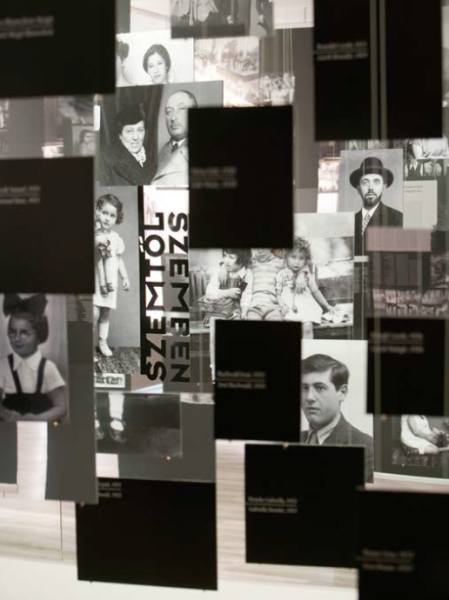Eye to Eye
Jewish Cultural Centre, Szombathely
Curator: Krisztina Kelbert
Design: Ferenc Kassai

ŌĆ£It is impossible but necessary, and therefore possible in spite of all (that is, incompletely).ŌĆØ Georges Didi-Huberman wrote this in his book on whether the Holocaust can be explained, written about and understood. This paradoxical aphorism condenses the ŌĆśinexpressible yet expressibleŌĆÖ horrors of the Holocaust. It is impossible to understand and portray what happened, yet one must because it demands an answer. In the first days of July 1944 nearly 3,000 Jewish citizens of Szombathely were crammed into cattle-cars and sent towards Auschwitz. In the summer of 1945 scarcely more than 300 people returned from the death camps. Nearly three thousand; scarcely three hundred. These are fates shrouded in approximate numbers, mere names that are unable to raise awareness of and clearly express the loss.
The exhibition ŌĆśEye to EyeŌĆÖ is intended to provide possible answers to these two dilemmas. Inspired by both the necessity to tell and to personalise the everyday lives of those who lived there it builds on the history of SzombathelyŌĆÖs Jewish community during the 19th and 20th centuries and attempts to render tangible the void left behind by the ravages of the Holocaust. Using the rich, emotional realm of photography and the multi-layered content of personal accounts it relates the dramatic devastation wrought by the Holocaust. The objectives of the exhibition are comprehension, representation and remembrance. Its method is to bring textual and visual representations into dialog. Its agents are the people who appear with their own gestures and movements, speaking in their own voices. Focussing on personal fates and human experiences, the exhibition presents the history of the 3,200 strong Jewish community through 957 archive photographs, 40 themes and the faces of 439 people, depicting the lives of individuals, families, groups, their communityŌĆÖs material and spiritual culture, religion, traditions, society and history, as well as its destruction in the Holocaust and its regeneration afterwards. By doing so it provides an insight into a part of SzombathelyŌĆÖs history that has remained hidden until now. At the same time, it allows one to see the every day history of Jews living outside the capital cities in Hungary and Central Europe through the prism of a specific community.
The recurring motif of the star shaped mirror allows us to face and reflect on history and individual human fate. Moreover, it prompts one to embark on an inner journey. In the words of Hermann Hesse: ŌĆ£Each manŌĆÖs life represents a road toward himself, an attempt at such a road, the intimation of a path.ŌĆØ By posing questions about stigma, empathy, responsibility and many other issues, a journey together through real and symbolic space might bring us closer to understanding our own personality, and also help in understanding history. The venue of the exhibition was formerly the upstairs classrooms of the Neolog Jewish Primary School from 1893 to 1944. For more than fifty years, from generation to generation, hundreds of Jewish students began their studies and lives within these walls. Legalised violence just before deportation turned it into a place of humiliation and brutality, events that left an indelible mark in the memories of the survivors. Seven decades of silence have remained in this buildingŌĆÖs past until the protagonists of the history of SzombathelyŌĆÖs Jewish community returned to tell their story in pictures and words.
Krisztina Kelbert
